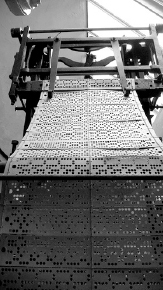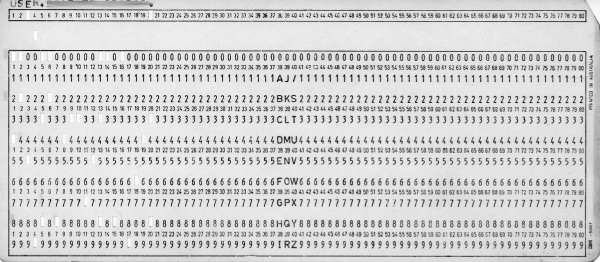012
The Jacquard Museum, Roubaix, France
 50° 40′ 59.05″ N, 3° 11′ 42.43″ E
50° 40′ 59.05″ N, 3° 11′ 42.43″ E
![]()
The Punched Card
The history of computing can be partially traced to a 19th-century French inventor named Joseph Marie Jacquard, who was interested in improving weaving and ended up being a major influence on the Industrial Revolution. His Jacquard loom was able to produce intricate woven patterns by reading a string of punched cards containing the pattern to be created, mechanizing a previously labor-intensive task.
The punched cards controlled which threads fell over or under each other, thus creating a pattern in the woven cloth. Prior to Jacquard’s automation of the loom, only simple patterns were possible because the positioning of threads was done by hand, or was at best partially automated.
A Jacquard loom was able—and still is, since the technology is alive today, with computers having replaced the cards—to produce an intricate pattern and repeat it by reading punched cards in a loop (see Figure 12-1).

Figure 12-1. Punched cards feeding into a Jacquard loom; courtesy of Justin Cormack
The place to see Jacquard’s technology in action is the Jacquard Museum in Roubaix, France. The museum has a collection of 15 working punched-card and electronic looms. Tours of the museum are available in English and can explain and demonstrate the entire weaving process, from the creation of a design to turning the design into punched cards and operating the looms.
The looms on display date from the 18th, 19th, and 20th centuries. The museum also offers workshops on the weaving process and actively restores looms to working order. There’s something for (almost) all the senses in the museum: the sound of the looms operating, the smell of the fabric and oil, hands-on exhibits, and the sight of these massive machines in operation.
After Jacquard, the punched card went on to be used in other areas. The inventor Herman Hollerith created a tabulating machine capable of reading punched census cards and producing statistical information by reading the card’s holes using a simple electrical circuit. Hollerith’s company handled the 1890 U.S. census, and later merged with another company to become IBM. There’s a Hollerith tabulator on display at the Computer History Museum (seeChapter 86).
The Jacquard loom also inspired Charles Babbage (see Chapter 77), who envisaged using punched cards to store programs for his Analytical Engine, an entirely mechanical computer. For roughly the first 70 years of the 20th century, punched cards were used as the input mechanism for computers (see Figure 12-2).

Figure 12-2. A 20th-century computer punched card;
courtesy of Peter Renshaw (bootload)
Practical Information
The Jacquard Museum’s website is at http://madefla.50g.com/ and is available in both English and French. If you can’t make it to Roubaix, an alternative is to visit a modern factory using Jacquard weaving techniques. In Northern Ireland, the Thomas Ferguson Irish Linen company in Banbridge, County Down, offers a factory tour that covers all aspects of the weaving process and explains the Jacquard loom itself. See http://www.fergusonsirishlinen.com/.
